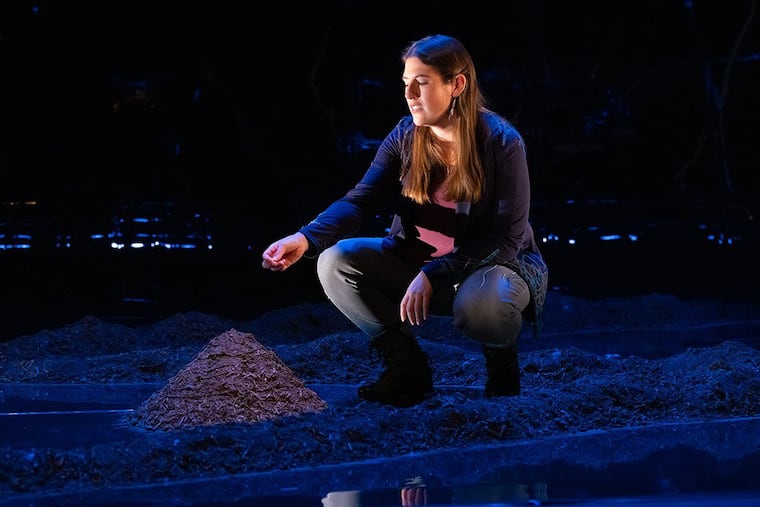Review: ‘Where We Belong’, a one-woman play about Native American heritage and history
Playwright and performer Madeline Sayet, portraying herself and others, explores language, borders, and flight.

There is considerable beauty in Madeline Sayet’s one-woman play, Where We Belong, a deliberately circular exploration of language, heritage, and history in which her personal story intersects with the larger one of her Mohegan people.
The show, produced by Washington’s Woolly Mammoth Theatre Company in association with Folger Shakespeare Library, is kicking off its first national tour at the Philadelphia Theatre Company’s Suzanne Roberts Theatre through May 8. (It will be the last production overseen by PTC’s producing artistic director, Paige Price, departing after a five-year tenure.)
Sayet, assistant professor of English at Arizona State University and executive director of the Yale Indigenous Performing Arts Program, is at once playwright, subject, and star. She is an expressive, likable performer, portraying herself, as well as her mother, a tribal elder, various border guards, and other characters.
This 80-minute exploration of her life and culture, directed by Mei Ann Teo, is meditative, meandering, and densely metaphorical. It is filled with poetic images and ideas, often about flight. But the show itself doesn’t always soar. The drama — about where, finally, Sayet belongs — is subtle. It could pack more of a punch, and it might, pared down to its essence, and in a more intimate theater.
Sayet is Mohegan only on her mother’s side. Her father is Jewish, but that part of her identity goes unexplored. Her Mohegan name means “blackbird”— a reference to the birds that flew into the house when she was born and to Flying Bird, the last fluent speaker of the Mohegan language.
The extinguishing of Native languages is only one of the tragedies touched on in Where We Belong. Sayet laments the broken treaties, the destructive ideology of Manifest Destiny, the brutal boarding schools and forced cultural assimilation, and museums’ acquisition of Native artifacts and human remains. James Fenimore Cooper’s 19th-century historical romance, The Last of the Mohicans, gets a couple of jabs as well. It’s a laundry list of righteous grievances.
Sayet puts her personal stamp on this broader history. Her obsession with language, we learn, leads her to Shakespeare, as an actor, a doctoral student in England, and finally a director. She is riveted by The Tempest, reading it as an attack on colonialism. She identifies with Caliban, seeing the creature as “no monster,” merely Indigenous, deprived of its native language.
Another of Sayet’s obsessions is with borders, “lines drawn in the sand by petulant children with guns.” She is a wanderer, searching for her real home, an identity she can inhabit. She recalls famous Mohegans from the past who traveled to England. The first, Mahomet, seeking justice from the Crown, would never return. That will not be her fate.
Hao Bai’s fanciful production design integrates lighting into the set. The stage floor is gleaming and reflective, a body of water, surrounded by mounds of dirt. Delicate lightbulbs hang from the ceiling, like teardrops, framed by sculptural fragments that double as multicolored fluorescent lights. The effects are often gorgeous.
Where We Belong
Presented by the Woolly Mammoth Theatre Company in association with Folger Shakespeare Library at the Philadelphia Theatre Co.’s Suzanne Roberts Theatre, 480 S. Broad St., through May 8. Mask and vaccination proof required. Tickets: $45-$55; $10 for essential workers; free for Indigenous peoples. Information: philadelphiatheatrecompany.org or 215-985-0420.